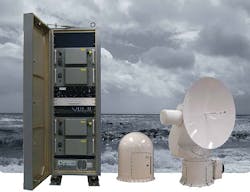Military asks for industry ideas on enhancing Common Data Link (CDL) for imagery and video
HANSCOM AIR FORCE BASE, Mass., 19 Dec. 2014. U.S. Air Force researchers are asking industry for ideas on how to improve standard military communications protocols for exchanging video and imagery to meet future demands for distributed military intelligence, surveillance, and reconnaissance (ISR).
Officials of the Space, Aerial & Nuclear Networks Division of the Air Force Life Cycle Management Center at Hanscom Air Force Base, Mass., issued a sources-sought notice this week for the New Capabilities for Common Data Link (CDL) project.
This initiative seeks to gather suggestions from industry on how to evolve the Common Data Link (CDL) to provide new capabilities to meet current and future military demand for distributing important intelligence video and imagery to forward-deployed forces that need the information quickly.
The Common Data Link (CDL) is a secure U.S. military communications protocol established by the U.S. Department of Defense (DOD) in 1991 as the military's primary protocol for imagery and signals intelligence.
Related: Researchers ask industry for ideas on Common Data Link radios for small manpackable UAVs
CDL operates at frequencies between 12 and 18 GHz at data rates as fast as 274 megabits per second in full-duplex data exchange. CDL signals are transmitted, received, synchronized, routed, and simulated by CDL interface boxes (CIBs).
The military's investment in CDL capability to distribute collected data to deployed intelligence analysts and warfighters significant has lagged sensor research, development, and fielding, Air Force officials say.
This uneven balance of investment threatens to slow the distribution of important ISR video and imagery among analysts and warfighters, and the Air Force as the DOD's executive agent of the CDL is asking industry to suggest ways to improve the CDL to provide new capabilities to meet current and future military demand for actionable intelligence information.
Air Force experts have a long wish list for new CDL capabilities, which include:
Related: Air Force eyes network-centric warfare common data link (CDL) of the future
-- developing affordable solutions for communications architectures by accommodating command-and-control (C2) data and different types of signals intelligence (SIGINT), geospatial intelligence (GEOINT), and full-motion video (FMV);
-- performing research, exploratory development, advanced development, test and evaluation, and systems engineering;
-- developing systems and subsystems including prototype or demonstration hardware/software and models;
-- planning and overseeing the integration of new systems;
-- leveraging CDL specifications for ISR operations worldwide and provide sensor data directly via point-to-point broadcast to ground sites, aircraft, vehicles, fixed sites, and infantry;
-- complying with government mandates to use spectrum and cryptographic equipment;
-- developing ways to relay data via air-to-air or satellite links when the asset and ground site are not in line-of-sight;
-- conducting research to support tactical, operational, and strategic ISR users;
-- developing anti-access/area denial (A2/AD) strategies and capability for missions requiring sustained air/land operations;
-- expanding the use of higher data rates to terminals and address additional size, weight and power (SWaP) improvements;
-- exploring technology for adapting networking and portable ground and lightweight airborne terminals;
-- enhancing multispectral operations, spectrum efficiency, and transmission components;
-- enhancing CDL-based ISR communications across different platforms and rapid prototyping efforts;
-- supporting emerging communication backbone architectures across space, air, and terrestrial layers, including agile high-capacity data transport, assured communications, and multi-note access networks;
-- supporting requirements documentation, program planning, and execution; and
-- building CDL prototype terminals that provide for future technology insertion and reduce non-recurring engineering and life-cycle costs to the user.
Companies interested and that have sufficient CDL experience should email white papers to the Air Force's Edna Alonis no later than 23 Jan. 2014 at [email protected].
For questions or concerns contact Edna Alonis by email at [email protected], or by phone at 781-225-4070. Also email or phone Christofer Palasinski at [email protected] or 781-225-4077.
More information is online at https://www.fbo.gov/spg/USAF/AFMC/ESC/CDL-20141216/listing.html.

